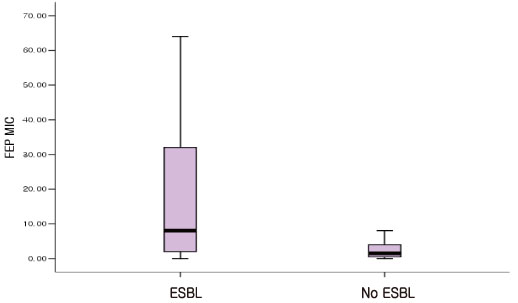Infect Chemother.
2010 Oct;42(5):280-284. 10.3947/ic.2010.42.5.280.
Prevalence of Extended-spectrum beta-lactamase among Enterobacteriacae Blood Isolates with Inducible AmpC beta-lactamase
- Affiliations
-
- 1Division of Infectious Diseases, Konkuk University Hospital, Konkuk University School of Medicine, Seoul, Korea.
- 2Department of Molecular Cell Biology, Samsung Medical Center, Sungkyunkwan University School of Medicine, Seoul, Korea.
- 3Division of Infectious Disease, Samsung Medical Center, Sungkyunkwan University School of Medicine, Seoul, Korea. krpeck@skku.edu
- KMID: 1806889
- DOI: http://doi.org/10.3947/ic.2010.42.5.280
Abstract
- BACKGROUND
Among the inducible AmpC beta-lactamase-producing members of the family Enterobacteriaceae such as Enterobacter spp., Citrobacter spp., Serratia spp., and Morganella morganii (ECSM), the prevalence of ESBL-producing isolates are increasing. However, there have been only a limited number of studies that have investigated the prevalence for ESBL-production in blood isolates of these organisms.
MATERIALS AND METHODS
We performed a prospective observational study to evaluate the prevalence for ESBL production among ECSM blood isolates. All consecutive blood isolates in the Samsung Medical Center were included from Oct 2006 to Mar 2008. Antimicrobial susceptibility test was performed by broth microdilution method. ESBLs were confirmed by double-disk synergy test and ESBL phenotypes were determined by PCR.
RESULTS
The 124 isolates (94 Enterobacter spp., 18 Citrobacter spp., 8 Serratia spp. and 4 Morganella spp.) were investigated. Among 124 ESCM isolates, 30 isolates (24.2%) showed ESBL-producing activity. Derepressed or partially derepressed AmpC mutants and derepressed AmpC mutants with ESBL production accounted for 36.3% (45/124) and 16.9% (21/124), respectively. Of ESBL producers, the most prevalent ESBL was SHV-12 (5/24, 20.8%).
CONCLUSIONS
The prevalence of ESBL-producing isolates is high in Enterobacter spp., Serratia marcescens and Citrobacter spp. clinical isolates. It suggested that routine screening test for ESBLs among Enterobacteriacae blood isolates with inducible AmpC beta-lactamase should be needed.
MeSH Terms
Figure
Reference
-
1. Paterson DL. Resistance in gram-negative bacteria: enterobacteriaceae. Am J Med. 2006. 119:6 Suppl 1. S20–S28.
Article2. Pfaller MA, Segreti J. Overview of the epidemiological profile and laboratory detection of extended-spectrum beta-lactamases. Clin Infect Dis. 2006. 42:Suppl 4. S153–S163.3. Choi SH, Lee JE, Park SJ, Kim MN, Choo EJ, Kwak YG, Jeong JY, Woo JH, Kim NJ, Kim YS. Prevalence, microbiology, and clinical characteristics of extended-spectrum beta-lactamase-producing Enterobacter spp., Serratia marcescens, Citrobacter freundii, and Morganella morganii in Korea. Eur J Clin Microbiol Infect Dis. 2007. 26:557–561.
Article4. Kim J, Lim YM. Prevalence of derepressed ampC mutants and extended-spectrum beta-lactamase producers among clinical isolates of Citrobacter freundii, Enterobacter spp., and Serratia marcescens in Korea: dissemination of CTX-M-3, TEM-52, and SHV-12. J Clin Microbiol. 2005. 43:2452–2455.
Article5. Pai H, Hong JY, Byeon JH, Kim YK, Lee HJ. High prevalence of extended-spectrum beta-lactamase-producing strains among blood isolates of Enterobacter spp. collected in a tertiary hospital during an 8-year period and their antimicrobial susceptibility patterns. Antimicrob Agents Chemother. 2004. 48:3159–3161.
Article6. Park YJ, Park SY, Oh EJ, Park JJ, Lee KY, Woo GJ, Lee K. Occurrence of extended-spectrum beta-lactamases among chromosomal AmpC-producing Enterobacter cloacae, Citrobacter freundii, and Serratia marcescens in Korea and investigation of screening criteria. Diagn Microbiol Infect Dis. 2005. 51:265–269.
Article7. Chow JW, Yu VL. Combination antibiotic therapy versus monotherapy for gram-negative bacteraemia: a commentary. Int J Antimicrob Agents. 1999. 11:7–12.
Article8. Jacoby GA, Han P. Detection of extended-spectrum beta-lactamases in clinical isolates of Klebsiella pneumoniae and Escherichia coli. J Clin Microbiol. 1996. 34:908–911.
Article9. Tzelepi E, Giakkoupi P, Sofianou D, Loukova V, Kemeroglou A, Tsakris A. Detection of extended-spectrum beta-lactamases in clinical isolates of Enterobacter cloacae and Enterobacter aerogenes. J Clin Microbiol. 2000. 38:542–546.
Article10. Livermore DM, Brown DF. Detection of beta-lactamase-mediated resistance. J Antimicrob Chemother. 2001. 48:Suppl 1. 59–64.11. Ko KS, Lee MY, Song JH, Lee H, Jung DS, Jung SI, Kim SW, Chang HH, Yeom JS, Kim YS, Ki HK, Chung DR, Kwon KT, Peck KR, Lee NY. Prevalence and characterization of extended-spectrum beta-lactamase-producing Enterobacteriaceae isolated in Korean hospitals. Diagn Microbiol Infect Dis. 2008. 61:453–459.
Article12. Navon-Venezia S, Hammer-Munz O, Schwartz D, Turner D, Kuzmenko B, Carmeli Y. Occurrence and phenotypic characteristics of extended-spectrum beta-lactamases among members of the family Enterobacteriaceae at the Tel-Aviv Medical Center (Israel) and evaluation of diagnostic tests. J Clin Microbiol. 2003. 41:155–158.
Article13. Bell JM, Turnidge JD, Jones RN. SENTRY Asia-Pacific Participants. Prevalence of extended-spectrum beta-lactamase-producing Enterobacter cloacae in the Asia-Pacific region: results from the SENTRY Antimicrobial Surveillance Program, 1998 to 2001. Antimicrob Agents Chemother. 2003. 47:3989–3993.
Article14. Moritz VA, Carson PB. Cefoxitin sensitivity as a marker for inducible beta-lactamases. J Med Microbiol. 1986. 21:203–207.
Article15. Szabó D, Bonomo RA, Silveira F, Pasculle AW, Baxter C, Linden PK, Hujer AM, Hujer KM, Deeley K, Paterson DL. SHV-type extended-spectrum beta-lactamase production is associated with reduced cefepime susceptibility in Enterobacter cloacae. J Clin Microbiol. 2005. 43:5058–5064.
Article16. Wi YM, Kang CI, Cheong HS, Chung DR, Jung CW, Ko KS, Song JH, Peck KR. Failure of cefepime therapy in neutropenic patients with extended-spectrum beta-lactamase-producing Gram-negative bacteraemia. Int J Antimicrob Agents. 2009. 33:384–386.
Article
- Full Text Links
- Actions
-
Cited
- CITED
-
- Close
- Share
- Similar articles
-
- Use of Boronic Acid Disks for the Detection of Extended-spectrum beta-lactamase and AmpC beta-lactamase in Escherichia coli, Klebsiella pneumoniae, Klebsiella oxytoca and Proteus mirabilis
- Detection of CTX-M-Type Extended-Spectrum beta-Lactamase in Clinical Isolates of Chromosomal AmpC beta-Lactamase-Producing Enterobacteriaceae from Korea and Their Molecular Characteristics
- Rapid Detection of Extended Spectrum beta-Lactamase (ESBL) for Enterobacteriaceae by use of a Multiplex PCR-based Method
- Characterization of Extended-spectrum Beta-lactamases in Klebsiella pneumoniae Isolated in Korea
- AmpC-type beta-lactamases in Clinical Isolated of Cefoxitin-resistant E. coli and K. pneumoniae


